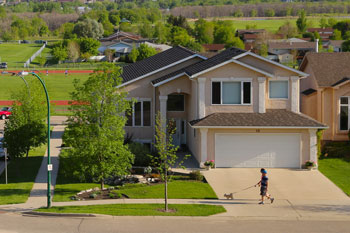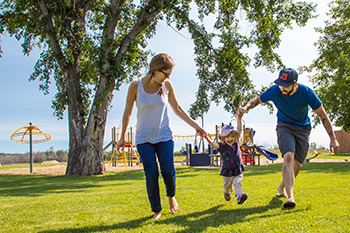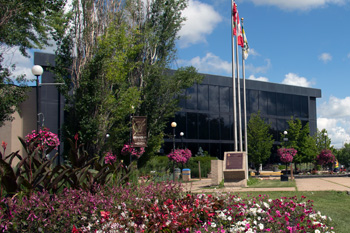Severe weather in Brandon can range from the extreme heat and wild storms of summer to unbearably cold blizzards in the winter.
Weather Warnings
Environment Canada monitors the weather 365 days a year. They issue special weather statements, watches, and warnings by radio, television, internet and their Weather radio. Weather radio is broadcast at 162.400, 152.475, and 162.550 megahertz and is picked up by dedicated radios and shortwave.
- Special weather statement: is provided so special attention is paid to weather conditions that are developing and may cause concern.
- Weather watch: conditions are favorable for a severe storm to develop.
- Weather warning: severe weather is happening or hazardous weather is highly probable.
What the warnings mean
Blizzard Warning
Snow/blowing snow; wind greater than 40 km/h, wind chill over 1600, visibility less than 1 km, conditions last 4 hours or more.
Heavy Snowfall Warning
Snowfall of 10 cm or more in 12 hours or less, or 15 cm or more in 24 hours.
Freezing Rain Warning
Slippery walking and driving, possible damage to trees and overhead wires due to ice.
Wind Chill Warning
Greater than 2200 watts/sq meter, very cold temperatures combining with wind to create outdoor conditions hazardous to human activity.
Severe Thunderstorm Warning
A severe thunderstorm has developed, producing one or more of the following conditions: heavy rain, damaging winds, hail (20 mm in diameter or larger), or intense lightning. The storm's expected motion and developments will be given.
Heavy Rain Warning
Heavy or prolonged rainfall is sufficient to cause local/widespread flooding. Expect 50 mm of rain over a 12 hour period or less, or 80 mm of rain in less than 24 hours.
Tornado Warning
One or more tornadoes in the area; expected development and duration will be given.
Wind Warning
Steady winds at 60 km/h or more, or gusting to 90 km/h or more, for at least 1 hour.
Extreme Temperatures
Heat
Summers bring at least one extreme heat wave which can cause problems if people are active and do not take precautions.
Things to do in Extreme Heat
- Slow down. Your body can't do its best in high temperatures.
- Get out of the heat and into a cooler place as soon as your body warns you that it's getting too hot.
- Drink plenty of water before you feel thirsty to keep your body from drying out.
- Maintain salt levels in your body. If you're on a salt-free diet, check with your doctor.
- Avoid high protein foods. They increase your body's water loss and heat production.
- Dress appropriately in light-weight, light-colored clothing. Wear a hat.
- Avoid getting sunburned; it restricts the body's cooling system. Use sunscreen of Sun Protection Factor (SPF) 15 or better.
- See "First Aid".
Extreme heat: heat waves - Canada.ca
www.gov.mb.ca/emo/prepare/heat.html
Wind Chill
Wind chill is a measure of the rate at which the wind cools people and animals to the surrounding air temperature. It is measured in watts per meter and expressed as a number. Wind chill will not cool an object below the actual air temperature, but cools it quicker than when there is no wind.
Wind Chill (watts/m2) with recommended procedures:
| 900 to 1400 | Hats, coats and gloves recommended. |
| 1400 to 1600 | Outdoor work and travel safe with quality winter clothing. |
| 1600 to 1800 | Frostbite can occur with prolonged exposure. |
| 1800 to 2000 | Frostbite can occur in minutes. Multiple layers of clothing required. |
| 2000 plus | Unprotected skin freezes in one minute. Face protection important. Children require continuous adult supervision. Work and travel alone is not advisable. |
| 2200 plus | Face protection mandatory. Work and travel alone is hazardous. Warm-up breaks are recommended for outside workers. |
| 2300 plus | Outdoor conditions become dangerous. |
| 2400 plus | Outdoor conditions are dangerous even for short periods of time. All non-emergency outdoor work should cease. Buddy system required. |
| 2600 plus | Rare wind chill values experienced in some major blizzards. Danger is extreme. |
Winter Storms
Blizzards
Blizzards come in on a wave of cold Arctic air, bringing snow, bitter cold, high winds, and poor visibility. On average, the storms and cold of winter kill more than 100 people in Canada every year, which is more than the total number of people killed by hurricanes, tornadoes, floods, lightning, and extreme heat.
Things to do in case of a blizzard
- When a blizzard is forecast, stay tuned for updates and check supplies.
- If on a farm with livestock, bring the animals into the barn. Give them plenty of water and food. Ensure the water does not freeze.
- String a lifeline between your house and any outbuildings you may have to go to during the storm.
- When a blizzard hits, stay indoors.
- If you must go outside, dress for the weather. Outer clothing should be tightly woven and water-repellent. Wear warm mitts and a hat, as 60% of body heat is lost through the head.
Severe Storms
Thunderstorms
A thunderstorm develops in an unstable atmosphere when warm moist air near the earth's surface rises quickly and cools. The moisture condenses to form rain droplets and dark thunder clouds. These storms are often accompanied by hail, lightning, heavy rain, high winds, and tornadoes. Thunderstorms are usually over in an hour, although a series of thunderstorms can last for several hours.
Hail
Hail forms when updrafts in thunderclouds carry raindrops upwards into extremely cold areas and freeze layer upon layer until they are too heavy and fall to the ground. Hailstones vary in size from peas to grapefruits and fall at great speed. People have been seriously injured by hailstones.
Things to do in case of a hail storm
- Take cover when hail begins to fall.
- Do not go out to cover plants, cars, or garden furniture, or to rescue animals.
Lightning
During a thunderstorm the air is charged with electricity. Bolts of lightning hit the ground at about 40,000 km per second -- so fast that the series of strikes hitting the ground appear as a single bolt.
Things to do in a lightning storm:
- Estimate how far away the lightning is -- every second between the flash of lightning and the thunderclap equals 300 meters. If you count fewer that 30 seconds, take shelter immediately.
- If indoors, stay away from windows, doors, fireplaces, radiators, sinks, bathtubs, appliances, metal pipes, telephones, and other things which conduct electricity. (You can use a cellular phone.)
- Unplug radios, computers, televisions and other electronic equipment.
- Do not go to rescue the laundry on the clothesline as it conducts electricity.
- If outdoors, take shelter in a building, ditch or a culvert but never under a tree
- If caught in the open, do not lie flat but crouch in the leap frog position and lower your head.
- Do not ride bicycles, motorcycles, or golf carts or use metal tools as they conduct electricity.
- If swimming or in a boat, get back to shore immediately.
- If you are in a car, stay there but pull away from trees which might fall on you.
- You may resume activity 30 minutes after the last clap of thunder.
Heavy Rain
A heavy rainfall can result in flooding. This is particularly true when the ground is still frozen or already saturated from previous storms. Floods may also result if a heavy rain coincides with spring thaw.
Things to do in a heavy rain storm
- If there is a possibility of flooding in your area, see "Floods".
- Do not drive through flood waters which can sweep your car away.
- Avoid crossing bridges if the water is high and flowing quickly.
- If visibility is impaired, slow down, or pull over and stop.
- Do not wade in, or drive through, flood waters. The strong current may sweep you downstream.
Tornadoes
Tornadoes are violent windstorms identified by their twisting funnel-shaped cloud. They are always produced by thunderstorms but not every thunderstorm produces a tornado. They travel between 20 and 90 km/h often moving from the southwest to the northeast. They are erratic and can change course suddenly. It is not a good idea to chase tornadoes. The warning signs are:
- severe thunderstorms with frequent thunder and lightning
- an extremely dark sky sometimes highlighted by green or yellow clouds
- a rumbling sound, such as a freight train or a whistling sound such as a jet aircraft
- a funnel cloud at the rear of a thunder cloud often behind a curtain of heavy rain or hail.
Things to do in case of a tornado:
- Listen to your radio during severe thunderstorms.
- If a tornado warning has been issued, take cover immediately.
- Go to the basement or take shelter in a small interior ground floor room, closet or hallway.
- Protect yourself by sitting under a heavy table or desk.
- Stay away from windows and outside walls and doors.
- Use stairways, not elevators.
- Avoid large halls, churches, arenas, etc.; Their roofs are more likely to collapse.
- Avoid cars and mobile homes -- take shelter elsewhere. If no shelter is available, lie face down in a ditch or culvert away from the vehicle or mobile home.
- If you are driving, try to get to a nearby shelter. Drive away from the tornado at a right angle.
- If the tornado is close by, take cover in a low-lying area.
- If a tornado seems to be standing still, it is either traveling away from you or heading right for you.
- In all cases, get as close to the ground as possible, protect your head and watch for flying debris.







